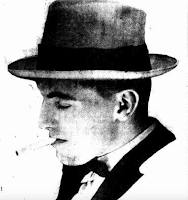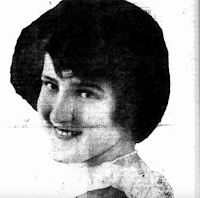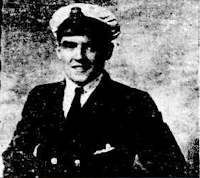The ballroom tragedy . . .
 |
| A pretty art student |
 |
| A vile seducer |
In 1925 Australia was gripped by a tragic story that had all of the elements of a sensational mystery thriller
or a lurid Hollywood movie.
Cyril Gidley was shot dead by his former fiancee, Audrey Jacob in front of hundreds of revellers at a charity ball in the early hours of Thursday 27 August 1925. When Audrey was arrested she was standing over the body and still held the smoking gun.
Cyril Gidley was shot dead by his former fiancee, Audrey Jacob in front of hundreds of revellers at a charity ball in the early hours of Thursday 27 August 1925. When Audrey was arrested she was standing over the body and still held the smoking gun.
It should have been (to use Australian gambling slang for a predicted easy victory) a "lay down misere" for the prosecution.
But Audrey had had the good sense to engage Arthur Haynes, Perth's most cunning defence lawyer, and nothing went as the Crown Prosecutor had planned . . .
 |
| Government House ballroom |
The Crime
The Government House ballroom in Perth, Western Australia, was brilliant with light and gaiety as a ball in aid of St. John of God Hospital was drawing to a close. A couple of hundred dancers gaily tripped the fox-trot to the cheery tune of "Follow Yvette," the thirteenth dance of the evening.
Few noticed the tall, slim girl with shingled dark
hair, dressed in a radium blue evening frock, who threaded her way through the
dancers. She moved as if in a dream towards a pleasant-featured, dark-haired young
Englishman in evening dress.
Twenty-five year old Cyril Gidley was enjoying his third dance with Miss Maude Mitchell when he felt a touch on his shoulder.
Turning, he saw Audrey Jacob, his former fiancee. Gidley looked at her coolly and said, "Excuse me, but I am dancing."
Twenty-five year old Cyril Gidley was enjoying his third dance with Miss Maude Mitchell when he felt a touch on his shoulder.
Turning, he saw Audrey Jacob, his former fiancee. Gidley looked at her coolly and said, "Excuse me, but I am dancing."
In reply, Audrey produced an automatic pistol and fired point blank into Gidley's chest. He placed his hand over his eyes as though suddenly feeling faint, then toppled to the floor. The bullet had severed his aorta and he died a couple of minutes later.
Audrey’s hand still held the smoking pistol. It dropped to her side as she remained motionless, staring at Gidley with a faint smile on her face.
At first, no one dared approach her, but after several minutes a constable removed the weapon and escorted her to an alcove where she remained, eerily composed, until taken to the police lock-up.
At first, no one dared approach her, but after several minutes a constable removed the weapon and escorted her to an alcove where she remained, eerily composed, until taken to the police lock-up.
Gentlemen of the Press
From the beginning, the press interest in the "ballroom horror" was frenzied. The circumstances of the crime, the inquest and the trial were reported in enormous detail, locally and across Australia. There was also international excitement, as Reuters sent detailed cables to America and Europe throughout the proceedings.
Almost from the moment of the shooting, the press coverage was in Audrey's favour and the local girl was given sympathy rather than censure.
Almost from the moment of the shooting, the press coverage was in Audrey's favour and the local girl was given sympathy rather than censure.
Audrey was 20 years of age, the second child and eldest daughter in a family of eight children. Her father was the Clerk of Court at Fremantle (the port city near Perth) and her family circumstances were respectable but not affluent.
Like all good heroines of romance, she was convent-educated (somewhat surprisingly, given her parents were Presbyterian). At the remote Roman Catholic Convent she had attended to age 16, Audrey had learned to paint. She kept up the practice afterwards and would sell her works privately. At the time of the murder she was living away from home and attending art classes in Perth.
In the period up to the inquest and trial she was
reported to be a model prisoner, who spent most of her time reading, especially "books of A
DEEPER KIND" and she had "asked for a Bible to be given to
her."
Photographs of Audrey in the newspapers emphasised her youthful prettiness and public opinion appears to have been firmly on her side from the beginning. For instance, her barrister's professional fees were paid for in part by a collection taken up for Audrey at the local Tattersalls club.
Her murdered lover, 25 year old Cyril Gidley, was an altogether different proposition. There was little public or press sympathy for the suave Englishman who had arrived in Western Australia two years before and was, at the time of his death, the Fourth Engineer on the State motor ship Kangaroo.
According to the press, Gidley had "a compelling personality". He had led people to believe that his family were wealthy and rather high in the social scale. He was "a man who fascinated girls".
As the Truth thundered: "Little wonder then that he fascinated Audrey Jacob, who was nothing if not ROMANTIC AND ARTISTIC in temperament."
A common trope in Australia is that of the "remittance man", an Englishman sent out to the colonies by his family to avoid trouble at home. Australians didn't much like remittance men, who they saw as England's rejects. And so, it was another black mark against Gidley that he had made it widely known that he had been sent out to Australia by his family, and given five years to "make good'' before his parents would take him back home to share in the family fortune.
Much worse, however, were the dark rumours that Gidley was the sort of man who deceived girls into thinking they were engaged to him and then dropped them. Gidley's engagement to Audrey had been formally announced in the newspapers in 1924, but some time before his death, the engagement had been called off.
Her murdered lover, 25 year old Cyril Gidley, was an altogether different proposition. There was little public or press sympathy for the suave Englishman who had arrived in Western Australia two years before and was, at the time of his death, the Fourth Engineer on the State motor ship Kangaroo.
According to the press, Gidley had "a compelling personality". He had led people to believe that his family were wealthy and rather high in the social scale. He was "a man who fascinated girls".
As the Truth thundered: "Little wonder then that he fascinated Audrey Jacob, who was nothing if not ROMANTIC AND ARTISTIC in temperament."
A common trope in Australia is that of the "remittance man", an Englishman sent out to the colonies by his family to avoid trouble at home. Australians didn't much like remittance men, who they saw as England's rejects. And so, it was another black mark against Gidley that he had made it widely known that he had been sent out to Australia by his family, and given five years to "make good'' before his parents would take him back home to share in the family fortune.
Much worse, however, were the dark rumours that Gidley was the sort of man who deceived girls into thinking they were engaged to him and then dropped them. Gidley's engagement to Audrey had been formally announced in the newspapers in 1924, but some time before his death, the engagement had been called off.
It was soon common knowledge that, just before he became engaged to Audrey, Gidley had tricked a girl in a
country town in Western Australia into thinking she was engaged to him by giving her an engagement ring. After he met Audrey, he had recovered the ring through a ruse, leaving the girl distraught. And when his mother was interviewed by Reuters in England, Mrs Gidley said that her son was engaged a girl residing at Cleethorpes in Lincolnshire, and the girl had expected to go out shortly to marry him. Such stories cemented Gidley's reputation as the sort of man who would deceive women when he could.
At the inquest and later at the trial, this negative
picture of Gidley became fixed. He was generally accepted to have been a cad, a bully and "a bit of a
swank".
The Coronial Inquest
[Audrey's outfit: "a pretty navy blue silk dress with Oriental trimming, over which she kept a heavy henna-coloured overcoat with fur cuffs." Her cloche hat was of the same colour with floral decorations.]
The inquest before the Coroner, held on 15 and September 1925, should have
been merely to establish the cause of death, but both Audrey's counsel, Mr
Haynes, and the Crown Prosecutor saw it as a dress-rehearsal for the criminal
trial. The strict rules of evidence do not apply at a coronial
inquest, and both lawyers tried to turn this to their advantage.
And as soon as the inquest began, it was
apparent that Mr Haynes, was going to attempt to blacken Gidley's character in a way
that would not be allowed at Audrey's criminal trial.
(I suspect that he was
hoping that the lavish press coverage of the inquest would mean that anyone chosen for the jury at trial would remember the evidence given at the inquest, and this would favourably dispose
them towards Audrey.)
The evidence of Audrey's mother at the inquest was sensational. She said that Gidley had made threats against Audrey's father (Mr Jacob). Gidley had tried
to poison her mind against her husband, who was opposed
to the marriage. As a result of Gidley's machinations, Mr Jacob had left the family
home to live in a boarding house. Not long afterwards Gidley arranged to stay at the same
boarding house, using the false name of Cyril Douglas, in order to spy on Mr
Jacob.
In vain the Crown Prosecutor tried to adduce evidence to show that Mr Jacob had left the family home in 1921, well before Gidley arrived on the scene, and the Jacobs' marriage was troubled for entirely different reasons.
Another sensational allegation put by Mrs Jacob was that Gidley was heavily involved in smuggling. As soon as her husband had left the family home, Gidley offered to pay to add two rooms to the Jacobs' house,
which could be used to store goods Gidley smuggled from Singapore. Mrs Jacob said she was horrified at the suggestion and told her husband. Together they had gone to the police, who searched Gidley's rooms for contraband.
In vain the Crown Prosecutor tried to emphasise that nothing had ever been proved against Gidley in this respect, and that the search carried out on Gidley's rooms on information laid by the Jacobs had revealed nothing nefarious.
Mrs Jacob also said that Gidley was domineering,
cruel and harsh to Audrey. She graphically described an occasion where he "put his hand on her throat
and pushed her head back until her hair fell down, and said that was what would
happen if she ever threw him over". Mrs Jacob wept to reveal her strong suspicion that Gidley had "seduced" Audrey (as one commentator put it, "anticipated the wedding night").
The Crown Prosecutor did his best to paint Gidley in a better light, but with little success. This evidence was from the owner of the boarding house where Gidley had stayed:
Crown Prosecutor: "There are three girls at the place and your wife says he (Gidley) never made any advances towards them."
Witness - How does she know?
Crown Prosecutor: "Did you ever see him do so?"
Witness - No
Crown Prosecutor: "You have never heard your wife or daughter complain of his conduct?
Witness - He was a bit of a swank, if that is any trouble.
However, the Crown Prosecutor did manage to put into evidence a very damaging letter that was allegedly found among Gidley's possessions. It read:
M.S. Kangaroo, Fremantle,
16/8/25. I, Cyril Gidley, do hereby state that Audrey Jacob visited me on the
above ship without my permission. While on board she tried to make herself a
nuisance and rejecting her advances, threatened me with my life if I didn't
make her my friend again. The reason I refused was she turned me down, using her
own words, "I have got plenty of good friends on the other ships";
this was just seven months ago, so I let her go to her good friends. (Sgd.)
CYRIL GIDLEY. 16/8/25. P.S.—This note is in case she does keep her vow.
Haynes did his best to downplay the letter, insinuating that it was a forgery.
Although Haynes valiantly attempted to persuade the Coroner not to make a finding of guilt, but to leave that for the criminal trial, the Coroner concluded:
"I find that Cyril Gidley died at Perth on August 27th, 1925, from haemorrhage, following a gun shot wound in the chest, the result of a shot from an automatic pistol fired at him by Audrey Jacob, of Perth, and that the said Audrey Jacob willfully murdered Cyril Gidley."
The Trial
[Audrey's outfit: "a cinnamon costume with white lace insertion and a broad silk sash of darker colour. Her hat was also cinnamon coloured, with floral trimmings.]The trial of Audrey Jacob for the murder of Cyril Gidley took place in the Perth Supreme Court on 8 and 9 October 1926.
Her defence was simple: accidental shooting.
Audrey's story was that she had arrived at the Government Ballroom on the night in question dressed as Pierrot with her friend Annie, who was dressed as Pierette. To her dismay she saw Gidley, whom she had thought was away at sea. He danced past her and snubbed her several times during the evening.
At midnight, agitated and distraught, she left the ball and returned to her flat where she lay down. After about a half an hour she rose, changed into her blue silk evening frock and took out the gun that had been given to
her by a former boyfriend. This she wrapped in her handkerchief.
Audrey said she left the flat determined to commit suicide and began walking to
the river, but on an impulse, she turned
and walked instead to the nearby Catholic Cathedral. Sinking to the ground by the wall of the cathedral, she recited the rosary. After a short period of contemplation and prayer, she felt more peaceful and decided not to kill herself after all.
In trance-like state she walked back to her flat. The route took her past Government House where the ball was still in
full swing, and she decided to go in to speak to Gidley. She asked her friend, Annie, to bring Gidley to meet her, but he refused to do so.
After this new rejection, Audrey saw Gidley on the dance floor. In a trance-like state, she moved through the dancers towards him, determined to speak to him. She tapped him on shoulder. He turned, saw her, and coldly replied, "Pardon me, I’m dancing".
Audrey felt dazed. She threw her hands up to her forehead, forgetting that she held the gun wrapped in her handkerchief. A shot rang out and Gidley fell to the ground.
She knew nothing more until she came to her senses in the lockup.
The Verdict
The all-male jury accepted Audrey's story and the verdict was an unequivocal, "Not
Guilty".
Even
today, apparently, students visiting the Supreme Court Building who are given a precis of the facts of the case for
a re-enactment tend to find Audrey "Not
Guilty". [“Somewhere between
fiction and non-fiction: New approaches to writing crime histories”, Anna Haebich, Curtin
University. http://www.textjournal.com.au/speciss/issue28/Haebich.pdf]
Was Gidley's death an accidental shooting? Or did Audrey cold-bloodedly murder her lover, as Gidley had reported that she had threatened to do a mere two weeks before?
In the February blog I will discuss the evidence adduced at Audrey's trial and you can decide for yourself whether Audrey Jacob really did get away with
murder...
 |
| Audrey Jacob |






Cold-blooded murder, m'lud. (Trance-like states, didn't know she had a heavy gun in her hand, it went off by mistake -- baloney.)
ReplyDeleteBut they sound two for a pair.
Looking forward to the February blog...
Fascinating and murky. Further investigation needed.
ReplyDelete